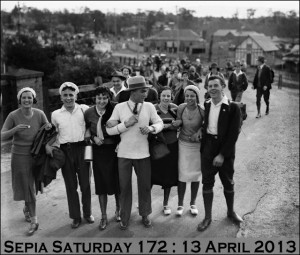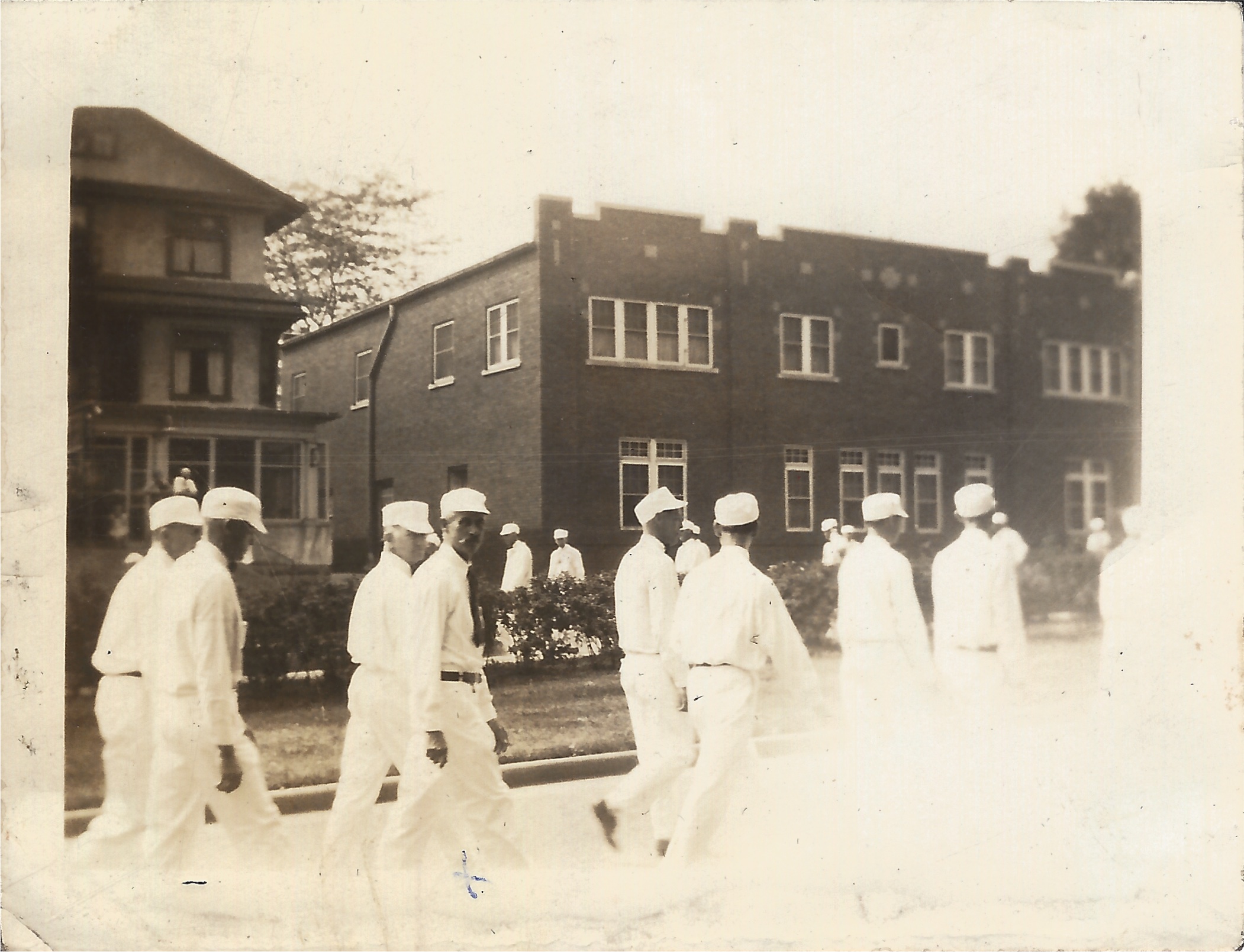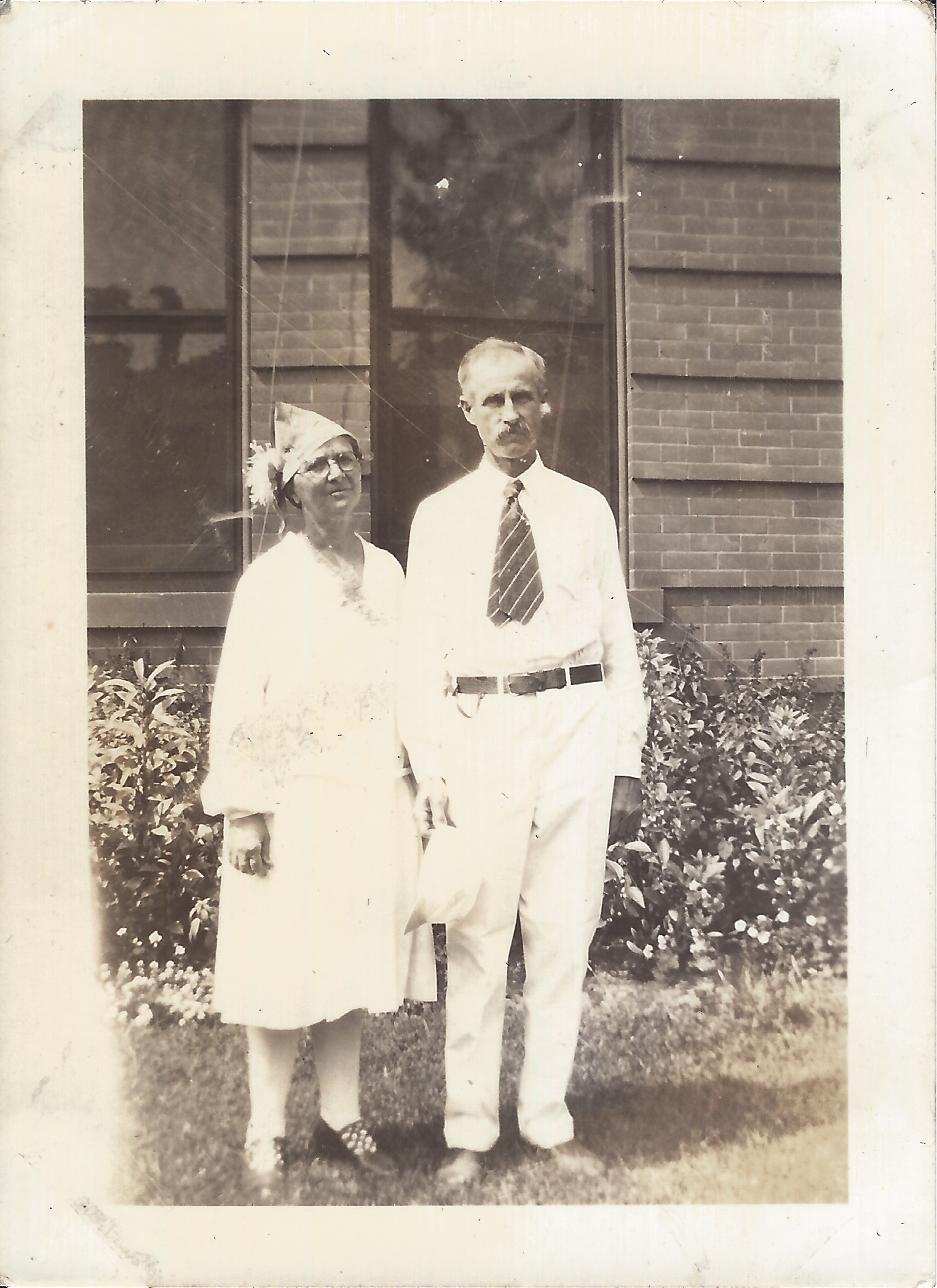 Sepia Saturday provides bloggers with an opportunity to share their history through the medium of photographs. Historical photographs of any age or kind become the launchpad for explorations of family history, local history and social history in fact or fiction, poetry or prose, words or further images.
Sepia Saturday provides bloggers with an opportunity to share their history through the medium of photographs. Historical photographs of any age or kind become the launchpad for explorations of family history, local history and social history in fact or fiction, poetry or prose, words or further images.
Today’s prompt photo is entitled “Palmer’s Mystery Hike No. 2”. My contribution is a photograph from my grandmother’s (Abbie Webber) photo album. It features people walking in a parade wearing hats – and it is a mystery to me and my cousins.
My great-grandfather, Myron David Webber, is the man who turned to face the photographer and there is an X by his legs. M. D. Webber was a school teacher early in his life and served as a pastor in several churches. He also learned the trade of plastering and earned, or supplemented, his income as a plasterer for many years.
Our best guess is that this picture was taken in Iowa City, Iowa, where M. D. Webber lived from 1926 until his death in 1959. My cousin thinks it looks like it could be on Iowa Avenue near downtown. Google doesn’t provide a street view of Iowa City at this time, so I couldn’t go panning up and down the modern street to see if any buildings look like those in the picture.
Although none of us are aware of Great-grandfather belonging to a union, I’m guessing that this is the local chapter of a plasterer’s union he belonged to – and maybe this was part of a Labor Day parade.
There is another photograph from the same page of the album that looks like it was taken the same day based on Great-grandfather’s clothing.
The woman in the picture is M. D. Webber’s wife and my great-grandmother, Dorinda Rebecca Strange.
I once posted “Strange in a Strange Uniform“. Here we have “Strange in a Strange Hat”.

Looks like a homemade hat for whatever the occasion or celebration.
Date? I’m guessing 1930s?
Now join the parade, hit the trails, or take a leisurely stroll to see what others have prepared for Sepia Saturday today.



What a mystery.. Can’t imagine plasterers wearing white as it would get dirty so quickly..but then maybe that’s how they showed how good they were!
The white didn’t surprise me so much because painters often wear white. But the tie was a bit of a surprise. Guess it was his “dress” uniform. I can’t tell if the other men are wearing ties, or if it was just my rather formal great-grandfather.
If you wear white, the white plaster that you get on your clothes won’t show as much as it would on darker clothes.
Intriguing. It looks like the plasterers may be demonstrating, two by two, on behalf of their union. Across the grass strip, on the other side of the road, they’re walking in the other direction, pair by pair. So maybe they’re walking in a circle, as demonstrators do. Of course, this doesn’t account for the hat. But your great-grandmother does appear to be wearing white. Maybe in solidarity!
I wondered about the men going in two directions on the divided street – not what you would expect in a parade. I never thought about the possibility of it being a demonstration. More to wonder about!
They certainly appear to be parading rather than demonstrating. You may be right about the union connection and this may also account for the ‘strange’ hat.
Another family mystery photo. Good luck finding the truth of the march/demonstration/parade.
Kathy, your great grandfather, was a teacher, pastor and had to augment his income with plastering. People were paid such a pittance; the unions had to fight hard in any profession for a decent wage. I read once a book about Goodyear and other tyre manufacturers. It was a horrible job to make the tyres. The men were paid a pittance for a 16 hour day without a rest in between. Pure exploitation.
A plasterers’ union parade, perhaps. Plasterers will surely wear hats to keep the plaster out of their hair. Fascinating.
Her shoes might be indicative of a specific time?!?
🙂
HUGZ